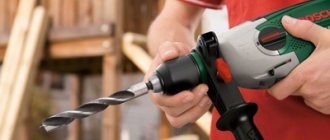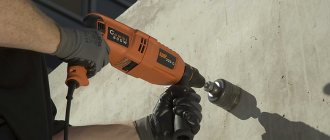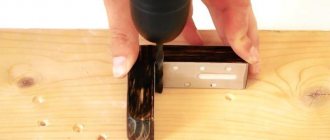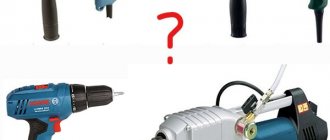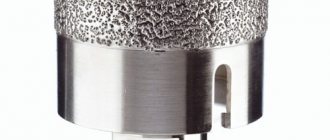How to drill a hole for a pipe in wood
If you need to make a large diameter hole in a tree, you will have to use special devices, each of which has its own characteristics. We will consider all possible options and tell you about their main advantages and disadvantages so that you can choose the best option in accordance with the specifics of the work in a given situation.
In the photo: equipment for wood differs from equipment for concrete and ceramics
Criteria for choosing a quality option
Below we will look at the main types of devices for cutting holes in wood, but for now we will outline the criteria that any option must meet, regardless of its modification:
| Reliable manufacturing material | Of course, it is unlikely that you can determine this criterion by eye, so it is best to ask the seller for a quality certificate for the product. Unreliable counterfeit versions from China most often do not have any documents. |
| High quality performance | Examine the product carefully: the surface must be smooth without flaws or defects, the cutting part must be carefully sharpened. If you purchase a long wood drill, check whether it is level; this can be done by eye or by rolling it over a flat surface - any irregularities will be immediately visible on it. |
| Good packaging | Low-quality fakes are most often packaged haphazardly, moreover, there are mistakes in the words. No well-known brand will allow itself unsightly packaging, remember this. |
| Price | Price is also an indicator of quality; as a rule, the most budget options do not last long, especially when it comes to large-sized drills and fixtures. After all, they are subjected to very high loads during operation. |
Advice! To be guaranteed to purchase a quality product, be it an electric jigsaw for wood or a circular saw, you need to contact official representatives of a particular brand or buy products from well-known stores that care about their reputation and do not sell cheap fakes.
Cheap core drill sets are so unreliable that they may only last for a single use
How to drill timber for dowels: review of low-speed drills
We will send the material by email
During construction, when working with wooden beams, special attention is paid to the connecting part of the crowns. As practice shows, changes in air temperature and water can change the shape of wood, even when dried according to all the rules. The use of dowels, which tightly fasten the structural elements together, will help to avoid this. But how can you make the necessary holes?
Types of products and their features
Let's look at what options you can find in our retail network and how they differ from each other.
Feather drills
The most common and budget option, which is quite convenient for even inexperienced craftsmen to work with. And you can also master this simple process with your own hands.
Let's look at the main advantages of this solution:
- The diameter range varies from 10 to 60 mm.
- The work is done quite quickly, but the quality of the hole is low, and it is unlikely to achieve an ideal result.
- The maximum drilling depth is approximately 150 mm.
- Products are sold either in sets of 5-6 pieces or individually, so you decide which option is right for you.
- If necessary, you can buy an extension that clamps the drill and increases its length by 300 mm.
Large sizes are usually sold individually, small sizes are usually sold in sets.
It is impossible not to mention such an interesting option as an adjustable pen drill; this type of product can make holes with a diameter of 22 to 76 mm. The work is carried out at low speeds using fairly powerful power tools.
Adjustable nib – a new word in products of this type
Forstner drill
This product option is used very widely in furniture production due to a number of undoubted advantages:
- The edges of the hole are perfectly smooth, which is not possible with other options.
- High reliability and long service life allow such devices to be used for years.
Massive nodes are very reliable
- The size range varies from 10 to 60 mm.
- The standard drilling depth is about 10 cm, but if desired, you can additionally purchase a 300 mm extension.
- This is the only option with which you can drill blind holes, because the centering pin protrudes only a couple of millimeters.
Screw drills
This option is very popular among those who drill large-diameter holes in wood to a considerable depth. To use them, you don’t need special instructions; just connect the unit to the power tool and you can start working.
The features include the following:
Spiral fixtures are available in a wide range of sizes
- This option is available in three lengths: 220, 450 and 600 mm. The last type is the most popular, since it can be used to effectively drill thick materials.
- It is best to use a drill with a rotation speed of 800 rpm. This allows you to carry out work most efficiently, but at the same time the power indicators of the power tool must be high.
- If you need to drill holes in log houses through 2-3 logs, then you shouldn’t even consider other options; this solution is optimal in all respects.
- The hexagonal shank allows you to securely fix the unit in the drill chuck.
All craftsmen who build log houses use this option.
Circular adjustable designs
The popular name for this device is wood ballerina. The design is a kind of compass, in the middle of which there is a centering drill, and cutting elements move on the crossbar, which can be installed in different positions.
The following factors can be considered features of this solution:
- With its help it is very good to process sheet materials and products up to 20 mm thick. The design copes well with both wood and fiberboard, chipboard, plywood and other similar options.
- The range of possible hole diameters is quite wide and ranges from 30 to 130 mm. This is much more than all the options described above, and the only drawback can be considered the small processing depth.
- The kit should include a hex wrench for adjusting the position of the cutting units and a center punch for making marks on the surface. It is recommended to carry out work at low speeds, since during the drilling process the cutting elements are subjected to very strong loads and can simply break.
This is what ballerinas look like when working with wood
How to choose and what to pay attention to
Choosing a high-quality circular drill is quite easy. The main thing is to know the main points that you should pay attention to first, but also not to lose sight of the little things.
The design is a very important point: a wood ballerina comes with one chisel or two or more. For frequent use, it is better to purchase an option with two or three cutting elements. It is easier to work with such devices and the quality of the processing performed will be at an acceptable level.
It would not be superfluous to be able to replace individual parts. Inexpensive circle drills can have a solid shank with a permanent center drill and rod.
Metal, its quality determines its strength and ability to withstand workloads. High-quality tools are made from high-strength steel or alloys. The shank and cutter holders are shaped using a machine tool. The rod is usually stamped and made of the same metal.
Cheap options often use soft metal or alloys, which can be brittle. Under load, parts may become deformed or break. Such a tool will not last long and it will also be difficult to achieve accuracy from it.
The quality of workmanship, the main feature is the absence of backlashes and distortions. All parts must fit together and be securely fastened with fixing screws.
The markings of a high-quality ballerina's barbell are stamped. Sometimes the divisions are highlighted with bright paint for better visibility.
Cutters and high-quality cutting elements are made from hardened tool steel. They are secured to the holders with rivets or soldering. Solid cutters with holders (made of the same metal) quickly become dull and are not durable.
Manufacturer, when choosing any tool and consumables, preference should be given to well-known and long-proven brands and brands. The most common are Topfix, Stayer, Irwin, Strum.
Purchasing an adjustable circular drill for use at home, or if you need to drill several holes, is completely worth it. This eliminates the need to purchase an expensive tool that may only be needed a few times.
Small diameter holes (up to 10-12 mm) in wood and chipboard are most often drilled with ordinary metal drills. They cope with their task quite successfully. But if every millimeter is important for the position of the hole, then you need to use special drills.
When entering wood, a metal drill may deviate slightly to the side, even if a recess is made with an awl at the site of the future hole.
In general, drilling wood can be done even with an ordinary nail or a piece of wire with a flattened end. Special drills for wood have to be resorted to only when it is necessary to drill a hole of large diameter, or when increased demands are placed on surface cleanliness and accuracy. There are several types of such drills:
- spiral (a);
- twisted or single-spiral (it is sometimes also called spiral) (b);
- feather (in);
- annular (crown) (d);
- Forstner cylindrical drill (d).
Wood drills are made from alloy tool and carbon tool steels; metal cannot be processed with them.
Twist drill
drill holes of small and medium diameter. It can easily be replaced with a metal drill bit, although the hole will be cleaner if you use a wood twist drill bit.
Single twist drill
It has a sharp cutting edge and a screw shape that removes chips well. It is used when you need to get an accurate deep hole with a clean surface of the walls.
Feather drill
They are usually used when drilling holes with a diameter of 10 to 25 mm, although there are drills with a diameter smaller than 10 and larger than 25 mm. This drill is the simplest in design and the cheapest, so it is reasonable to use it in all cases where high demands are not placed on the quality of the hole. The disadvantages of a feather drill include poor direction, low diameter accuracy, rough surface of the hole walls, and the need to periodically remove chips by stopping drilling and removing the drill from the hole. The advantages are simplicity and low cost.
Crowns
used when drilling large diameter holes - up to 100 mm or more. The kits contain one mandrel with a shank and a centering drill and several bits that are inserted into the mandrel.
Forstner drill
has a centering point and a sharp scorer. Thanks to the latter, it is distinguished by precise cutting geometry. Typically used for drilling blind holes to precise dimensions in softwood, chipboard or laminate for the installation of furniture canopies.
Forstner drill bits can be short or long pointed.
It is more difficult to make a blind hole for a hinge in a thin door with a Forstner drill with a long point, since the point can make a through hole. But a drill with a short tip is more prone to moving to the side. In addition to differences in the length of the tip, the Forstner drills shown in the photo above differ in their maximum rotation speed. So a drill with a short tip has welded knives made of high-speed steel and is suitable for working at high speeds, and a drill with a long tip has a maximum rotation speed when working with soft wood equal to 1000 rpm.
There is another device for cutting large holes - this is a ballerina
, designed for cutting large (up to 300 mm) holes in thin pieces of wood, chipboard, fiberboard and other materials.
The ballerina consists of a centering drill and two cutters that are used to cut out a circle. The displacement of the cutters along the guide sets the diameter of the circle being cut. To rotate the ballerina, use a brace or drill with a low speed. You can also rotate it manually.
How to drill wood and chipboard
To prevent the drill from going to the side at the very beginning of drilling, you need to make a small depression in the center of the future hole with an awl.
Drilling wood is carried out at low and medium speeds of the drill. The main problem when drilling through holes is chipping at the drill exit. There are two ways to deal with them. First drill a thin hole and drill along it from both sides of the part to the middle with a drill of the final diameter. In this way, it will be possible to avoid chips that occur at the exit. The second method is to firmly press a piece of wood onto the side where the drill comes out, which is removed after drilling. To make the drill perpendicular, jigs are used. The latter are especially convenient for making holes in cylindrical parts.
Drilling chipboard requires special attention due to its fragile structure. The presence of laminated or veneer coating complicates the task. To avoid their peeling, use drills with a sharp edge (in particular, a cylindrical Forstner drill) and a backing plate at the exit. To mark holes, be sure to use an awl.
When using the content of this site, you need to put active links to this site, visible to users and search robots.
For high-quality performance of even such a simple procedure as drilling holes in wood products, the correct mode and the appropriate tool are required. When choosing a wood drill, you should take into account the characteristics of both the material being processed and the hole that needs to be made. The modern market offers a wide variety of drills designed for making holes in wood, so choosing a tool to solve certain technological problems will not be any particular problem.
A large hole in a log - how to make it?
How can you make a large (D110 mm) hole in a log? It was necessary to pass a small sewer pipe (D50 mm) into the log house - I drilled it with a Faustner drill bit with an extension. With a log diameter of almost 40 cm, I almost died while drilling, but it turned out well and evenly. Now you need to punch a hole for a large D110 mm pipe. For now, all I can think about is a chain saw. But the resulting hole will be square and uneven, and you will have to cut right up to the ceiling - it’s difficult and not safe. Maybe there is some more rational solution?
There are many holes in diameter, then knock them out with a sledgehammer.
anly wrote: Maybe there is some more rational solution?
Eat. Drill with a hole saw into wood of the required diameter to the depth of the hole. Then use a chisel to select the core and drill further to the depth of the crown. And so far not all the way through. Crowns should not be composite or adjustable, but one-piece, in the form of a solid cup. That's what I did.
Hubert wrote: then knock it out with a sledgehammer
in a log? 2anly A crown with an extension » > and a long chisel
I missed something that wood crowns of this size are sold. I will try. Regarding the many holes and then knocking them out - with such a thickness of logs, the wood borax still leads to the side. Therefore, it will be almost impossible to drill many holes exactly so that they come out evenly from the opposite side.
I'll just look for bimetallic ones instead. I have experience working with these cheap Chinese ones - they get stupid extremely quickly.
anly wrote: Therefore, it will be almost impossible to drill many holes exactly so that they come out evenly from the opposite side.
Can. But you need to drill according to a template made of 10 mm plywood. It’s better not to use a drill, but to use a hammer drill with the hammer turned off - it has a larger base and it’s easier to ensure the parallelism of the axis holes. Crowns are easier and better, but they are not cheap.
I ordered a crown. I will try.
Maybe you can make a crown yourself from a steel pipe of suitable diameter and length? cut teeth, part and sharpen. weld a circle with a central hole on the back side. screw the rod (and can be scalded along the way) so that its front end is in front of the teeth of the crown and serves as a guide for it (inserted into a pre-drilled hole in a log with a diameter corresponding - or a couple of dozen less - to the rod). something like this. It’s true that I stated the theory
I didn't drill it myself. Maybe someone will think of something. Or I also read on the Internet: “..When drilling a large diameter hole (20-30 mm) in a tree, you may not have the necessary drill or perk. In this case, first drill a hole of a smaller diameter, and then insert a flat steel washer (preferably a new one) into the rotor chuck and go through the hole again. This method is also applicable for countersinking holes. “For your 1100mm, I think you should look for or sharpen the appropriate washers/a la milling cutter. True, it will take a long time to twist/scrape the wheel, like Dantes’s underground passage from the Château d’If
Source
Criteria for choosing a quality option
Below we will look at the main types of devices for cutting holes in wood, but for now we will outline the criteria that any option must meet, regardless of its modification:
| Reliable manufacturing material | Of course, it is unlikely that you can determine this criterion by eye, so it is best to ask the seller for a quality certificate for the product. Unreliable counterfeit versions from China most often do not have any documents. |
| High quality performance | Examine the product carefully: the surface must be smooth without flaws or defects, the cutting part must be carefully sharpened. If you purchase a long wood drill, check whether it is level; this can be done by eye or by rolling it over a flat surface - any irregularities will be immediately visible on it. |
| Good packaging | Low-quality fakes are most often packaged haphazardly, moreover, there are mistakes in the words. No well-known brand will allow itself unsightly packaging, remember this. |
| Price | Price is also an indicator of quality; as a rule, the most budget options do not last long, especially when it comes to large-sized drills and fixtures. After all, they are subjected to very high loads during operation. |
Advice! To be guaranteed to purchase a quality product, be it an electric jigsaw for wood or a circular saw, you need to contact official representatives of a particular brand or buy products from well-known stores that care about their reputation and do not sell cheap fakes.
Cheap core drill sets are so unreliable that they may only last for a single use
How to make large holes in walls? Choosing the optimal tool
Drilling large holes requires large nozzles, and they are different for wood and concrete. We will tell you which attachments to use for which tasks and recommend reliable drills.
To drill holes for air conditioner mounts, cable pulling, installation of a soldered pipe for water supply or connecting furniture structures, you will need a large drill. Although large nozzles for wood and concrete are somewhat similar, they are still intended for different tasks and they are not interchangeable. We will tell you about them and recommend a couple of good attachments for wood and concrete. We have already told you how to distinguish drills for wood, metal and concrete. Here we will focus on large attachments, which we do not use very often, but without which we can’t go anywhere in everyday life.
Direct purpose of dowels
Dowels are peculiar pins, the installation of which is carried out perpendicular to the axis of the elements. They are used to connect adjacent crowns. The main task of timber dowels is to prevent the elements from moving. This is due to the fact that even dry elements of a wooden frame can be deformed during operation, which is caused by various factors, for example, humidity. The use of this component for fastening does not allow the possibility of wood deformation, because they tightly connect the crowns of the frame with each other.
You can hear many opinions that the dowel serves to tie the frame, but such a judgment is erroneous. This component is designed to ensure that when the timber shrinks and dries, it does not lose its original position, so that the structure of the building does not move.
Types of products and their features
Let's look at what options you can find in our retail network and how they differ from each other.
Feather drills
The most common and budget option, which is quite convenient for even inexperienced craftsmen to work with. And you can also master this simple process with your own hands.
Let's look at the main advantages of this solution:
- The diameter range varies from 10 to 60 mm.
- The work is done quite quickly, but the quality of the hole is low, and it is unlikely to achieve an ideal result.
- The maximum drilling depth is approximately 150 mm.
- Products are sold either in sets of 5-6 pieces or individually, so you decide which option is right for you.
- If necessary, you can buy an extension that clamps the drill and increases its length by 300 mm.
Large sizes are usually sold individually, small sizes are usually sold in sets.
It is impossible not to mention such an interesting option as an adjustable pen drill; this type of product can make holes with a diameter of 22 to 76 mm. The work is carried out at low speeds using fairly powerful power tools.
Adjustable nib – a new word in products of this type
Forstner drill
This product option is used very widely in furniture production due to a number of undoubted advantages:
- The edges of the hole are perfectly smooth, which is not possible with other options.
- High reliability and long service life allow such devices to be used for years.
Major manufacturers of low-speed drills
The quality of the instrument depends on the reputation of the manufacturer. Experienced craftsmen identify a number of models that deserve attention.
Makita
A brand from Japan, specializing in the production of electric tools, has gained worldwide trust due to the quality of its products. Among the variety of drills from this company, the unit model 6300-4 is popular. The specimen is suitable for high-quality work by experienced craftsmen. The price is within 14.5 thousand rubles. The tool allows you to perform all popular tasks, including preparing solutions.
Felisatti
The Italian manufacturer, whose brand produces everything needed for construction work, also produces low-speed drills. The professionals appreciated the professionalism of the Italians, choosing the DMF23/1150VSE device among popular models.
Metabo
Among countries producing power tools, Germany ranks high, distinguished by reliable and high-quality products. Metabo produces drills that any DIYer will appreciate. However, the high cost of the devices deters non-professional construction workers from purchasing them. Thus, the price of the common B32/3 drill model is 59 thousand rubles. Not everyone can afford to work with an expensive tool.
Russia
If, when choosing a manufacturer, the question is about saving money, you should pay attention to Russian brands. The efficiency of Interskol or ZUBR tools is at the level of foreign competitors. The availability of products from domestic companies forces craftsmen to make a choice in their favor.
The task is to drill a large hole in the tree. The solution is wood crowns.
I welcome all visitors to my website, where I talk about various types of tools, give advice and recommendations on choosing and working with one or another tool. Today we will look at a tool with which you can easily drill a large-diameter hole in thin wood, most often plywood, fiberboard and chipboard.
The tool is a hole saw for wood, most often sold in sets with different saw diameters. This is very convenient - I bought one such set and you can drill holes of any large diameter, of course, if the saws that come in the set are of the diameter you need. Photo of this set:
For use at home, the Stayer set is quite suitable; it is optimal in terms of price and quality, moderately expensive, and comes with many saws of various diameters. It is worth noting that there are several variations of diameters, there are more complete sets with a large number of crowns, the diameters start from the smallest to the very large.
The most popular and best-selling set is 19-127 mm, this set contains 12 hole saws for wood of various diameters, it can be said to be universal, since it is almost always possible to select a crown for the desired diameter. However, its cost is 480 rubles. If you take sets with fewer attachments, then it will cost less.
So, let's look at the pros and cons of such a tool.
- Versatility - the ability to choose a crown for almost any diameter.
- Convenient suitcase, everything is stored in one place.
- Quick drilling of fiberboard, chipboard, plywood.
- The cut is not clean, unlike the holes drilled with a forstner drill.
- Sometimes it is not possible to choose the right diameter, for example, for some spotlights.
- Drilling depth is only 30 mm. Of course, you can drill deeper, but you will have to knock out the wood every time when the crown rests on the tree, because it is not deep.
All in all, a hole saw is a must-have tool for the home. For example, I recently pulled a 110 mm pipe through a thin partition (double layer of chipboard with a 50 mm block between them). How to drill 110mm holes in plywood?
Also note: A thousand ways to use alignments
There are several options - you can use a jigsaw, using a thin file for a figured cut. It is quite possible to drill a round hole, but you still won’t get a perfect circle.
But take a set of circular saws, choose the diameter of the bit closest to 110 mm, assemble it and drill a smooth, beautiful hole in a few minutes.
What is a wood ballerina
A circular adjustable ballerina drill is a device that is designed for drilling round holes of large diameter. The tool has a simple design. It consists of a shank with a transverse rod on which movable carriages with cutters are attached. The rod has markings according to which you can set the required spread of the cutters relative to the center of the intended hole. A core drill is fixed in the middle of the shank. It serves as a centering element and support when drilling.
In addition to designs with two cutting elements located symmetrically, there are ballerinas with one cutter or even three. In the latter case, they are located on the base in the form of a disk with grooves.
Video description
Circular drill
Masters call this device a ballerina, since the principle of operation of the drill resembles the movements of a dancer. The cutting element consists of a central drill and additional cutters located on a common axis. The position of the cuts can be changed, thereby adjusting the diameter of the future hole. The circular drill set includes a punch intended for marking and a hexagon required for fixing the drills.
A cutting element of this type is chosen in the following situations:
Drilling with a circular element is best done with a low power drill, since there is a high probability of damage to the device.
What drills are needed for woodworking?
Wood drill bits are suitable not only for solid wood, but also for plywood, chipboard and fiberboard. Their characteristic feature is a centering point - a spike on the tip that stabilizes the drill when starting it. The design of their spiral blade allows the chips generated during drilling to be thrown out.
As a standard, they have a diameter from 3 to 12 mm and a rolled shank, allowing drilling to a depth of up to 1000 mm. Only small drill bits designed for drills or electric screwdrivers have a hex shank (bits, screwdrivers).
types of wood drills
Drill bits are used to make deep holes in solid wood pieces. The spiral of their blade is wide, which greatly facilitates the ejection of chips. The augers have a larger diameter than conventional wood drills - from 6 to 40 mm.
Tool functionality
A high-quality ballerina is made of high-strength steel, which makes it possible to use the device in working with soft and hard wood.
This tool has an adjustable drilling diameter. This allows you to make holes of almost any diameter. The limitation of the drilling range depends on the size of the ballerina. Manufacturers produce devices with the following cutter spread limits:
The maximum drilling diameter is limited by the rod on which the cutters are mounted. The minimum is the thickness of the shank.
A ballerina drill can be used in any places where using a jigsaw or a hand router would be inconvenient. For example, this may be assembled and installed furniture, in the part of which it is necessary to drill a neat hole, given the limited space. Another example is an uneven (concave or curved) surface. It’s unlikely that you’ll be able to do everything smoothly and neatly with a jigsaw or milling cutter. It will be difficult to control the inclination of the tool relative to the surface. A ballerina can easily cope with this task.
Techniques for drilling holes in wood
Countersink hole for screw head
There are situations when you need to drill a “blind” hole for a tenon joint. To do this, you need to use a feather drill with a limiter, which is placed on the drill according to the size of the drilling depth
It is more difficult to make holes in large-diameter wood, since the use of conventional cylindrical drills chips the surface of the material, spoiling its appearance. To successfully cope with this task, feather drills and annular cutters are used.
Drilling with feather drills
For successful drilling with feather drills, secure the wood firmly in a vice and press the tip of the drill bit against the surface of the material. Then drill (at low speed) the hole until the tip of the drill appears at the bottom of the wood. Stop drilling and remove the feather bit from the hole, then turn the wood over, clamp it in a vice and drill the hole on the other side. This will prevent the block from splitting when drilling.
Drilling with an annular cutter
Wood annular cutter
An annular cutter is used for drilling holes in wood with a diameter greater than 38 mm. Drilling begins with a small-diameter guide drill, structurally connected to the cutter in one piece. This guide serves as a guide for the annular cutter.
Here are some tips from professionals that will surely help you when drilling holes in wood:
a) for vertical drilling, you can install a square parallel to the drill;
b) if you often have to do carpentry work, purchase a special stand for a drill, which allows you to hold the tool strictly vertically and controls the depth of the holes; c) be sure to use a vice when drilling to avoid splitting the wood; d) so that the outlet hole does not have chips, place an unnecessary block under the wooden part and drill them together. This is especially applicable when making holes in a thin board; e) if you do not have a drilling depth limiter, wrap the drill in the area of limitation with bright electrical tape or masking tape.
Video description
See the video for a clear overview of the dowels:
Installing a dowel is a fairly straightforward matter. It is hammered into the hole, but not completely, so as not to create a crack in the beam. The pin must fit into the finished hole without undue difficulty, so that the wood can shrink freely in the future. The distance that is left between the fasteners must be calculated based on the construction documentation. Installation is carried out in a checkerboard pattern. Before installing the fastener, it is lubricated with a special construction adhesive, and then hammered in with a mallet.
Drilling a hole for the dowel Source sruboff.org
This might be interesting!
In the article at the following link, read about how to plaster a wooden house inside and out.

